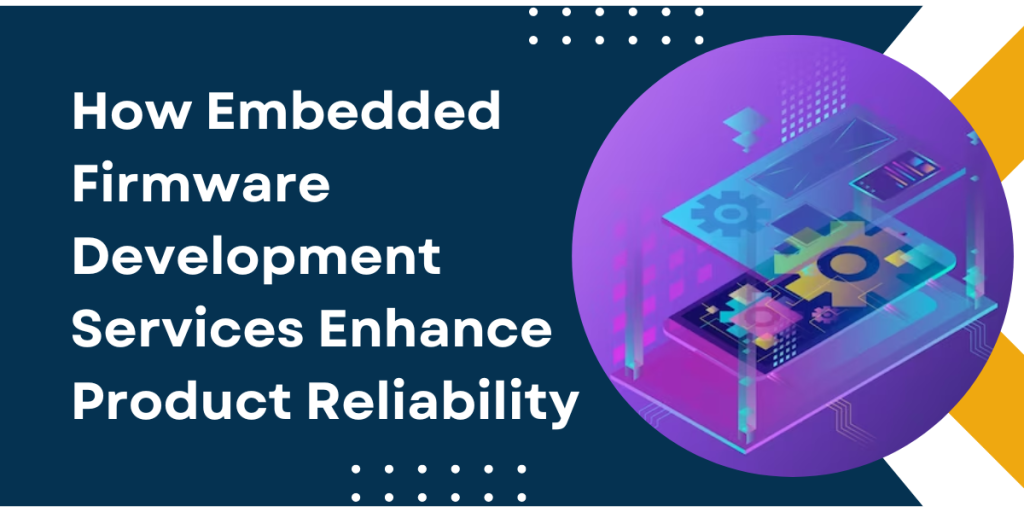
Embedded firmware plays a vital role in modern products, serving as the software that controls hardware functionality. Product reliability is crucial, as it directly influences customer satisfaction and brand reputation. Embedded firmware development services are essential for ensuring reliable products by effectively designing, testing, and maintaining firmware. This article explores how these services contribute to enhancing product reliability, addressing the complexities of firmware development, and highlighting the significance of collaboration between hardware and firmware teams. By employing best practices and thorough testing, these services help create dependable products that meet customer expectations and bolster a company’s reputation.
Overview:
Embedded firmware refers to the software that controls the operation of hardware in modern products, from consumer electronics to industrial machinery. The development process involves intricacies due to the close integration between firmware and hardware. Key considerations during firmware development include hardware compatibility, efficient memory utilization, and real-time constraints. Developers must understand the hardware’s capabilities and limitations to optimize firmware performance. The process typically involves writing low-level code in programming languages like C or assembly language. Moreover, firmware development necessitates a thorough understanding of the target application, user requirements, and industry standards. Proper documentation and version control are essential to manage the complexities and changes that may arise during the development lifecycle.
How Embedded Firmware Services Enhance Product Reliability:
Embedded firmware services play a critical role in enhancing product reliability by ensuring that the software controlling the hardware functions flawlessly. Firmware acts as the bridge between the hardware and the end-user, influencing the product’s overall performance and functionality. Through meticulous development and testing, firmware services eliminate bugs, enhance system stability, and optimize power consumption.
Collaboration between hardware and firmware development teams is crucial for achieving reliability. Close communication allows firmware developers to understand hardware specifications thoroughly, ensuring that the firmware is tailored to the hardware’s capabilities and limitations. This collaborative approach facilitates the identification and resolution of compatibility issues early in the development process, minimizing potential failures.
Another vital aspect is ensuring compatibility with hardware components and the overall system architecture. Firmware services work to integrate the firmware seamlessly with different hardware elements, such as sensors, processors, and memory modules. By considering the entire system architecture, these services can avoid conflicts and create a reliable and efficient ecosystem.
Best Practices
Best practices in embedded firmware development services ensure the creation of reliable and efficient firmware for products. Some key practices include:
1. Utilizing Version Control and Continuous Integration: Implementing version control systems like Git allows for better code management, collaboration, and tracking changes. Continuous integration automates the build and testing process, enabling quick identification and resolution of integration issues, ensuring a stable codebase.
2. Code Optimization and Efficient Memory Management Techniques: Optimizing firmware code reduces resource usage and improves performance. Techniques like code refactoring, using optimized algorithms, and minimizing unnecessary operations contribute to efficient firmware. Proper memory management prevents memory leaks and optimizes memory usage for stability and responsiveness.
3. Addressing Security Concerns and Implementing Secure Coding Practices: Security is critical in embedded system services. Firmware services must follow secure coding practices to protect against vulnerabilities like buffer overflows, injection attacks, and unauthorized access. Regular security audits and code reviews help identify and fix potential security weaknesses.
Testing and Validation of Embedded Firmware:
Comprehensive testing and validation are crucial for ensuring reliability. Rigorous testing helps identify potential issues and bugs that could lead to malfunctions or security vulnerabilities. Various testing methodologies are employed in embedded firmware development solutions, including unit testing, integration testing, system testing, and acceptance testing. These tests verify the functionality, performance, and compatibility of the firmware across different hardware configurations. Additionally, stress testing and edge case testing assess the firmware’s resilience under extreme conditions. Strategies for bug identification and resolution involve the use of debugging tools, logging, and thorough error handling mechanisms. Continuous integration and version control aid in maintaining a stable codebase and facilitate prompt bug fixing.
Over-the-Air (OTA) Updates and Maintenance:
Over-the-Air (OTA) updates are a valuable feature in firmware maintenance, offering several advantages. OTA updates enable hassle-free and cost-effective firmware updates without requiring physical access to devices. This capability enhances product reliability by addressing bugs, adding new features, and improving security over time. To ensure secure and seamless OTA updates, firmware services implement robust encryption and authentication mechanisms to protect against unauthorized access or tampering. Challenges related to remote firmware updates include network stability, update size management, and potential interruptions during the update process. These services address these challenges through careful planning, error handling, and rollback mechanisms to ensure successful OTA updates.
Conclusion:
In conclusion, reliable embedded firmware is paramount in ensuring product reliability, as it directly influences customer satisfaction and brand reputation. It serves as the critical link between hardware and end-users, affecting a product’s performance and functionality. Professional development services play a pivotal role in this regard, offering expertise, experience, and adherence to best practices to create high-quality firmware.
Investing in high-quality firmware services brings numerous benefits to companies. Firstly, it results in robust and dependable products that meet customer expectations and withstand real-world conditions. Reliable firmware also minimizes the risk of costly recalls or post-launch issues, saving both time and resources. Moreover, professional services provide timely updates and ongoing support, ensuring products remain up-to-date, secure, and competitive in the market.
By partnering with experienced firmware development teams, companies can streamline the development process, optimize performance, and reduce time-to-market for their products. The value of dependable firmware extends beyond immediate gains, contributing to long-term customer loyalty and brand trust. In the competitive landscape, investing in high-quality firmware services is a strategic decision that can lead to sustained success and growth for businesses.